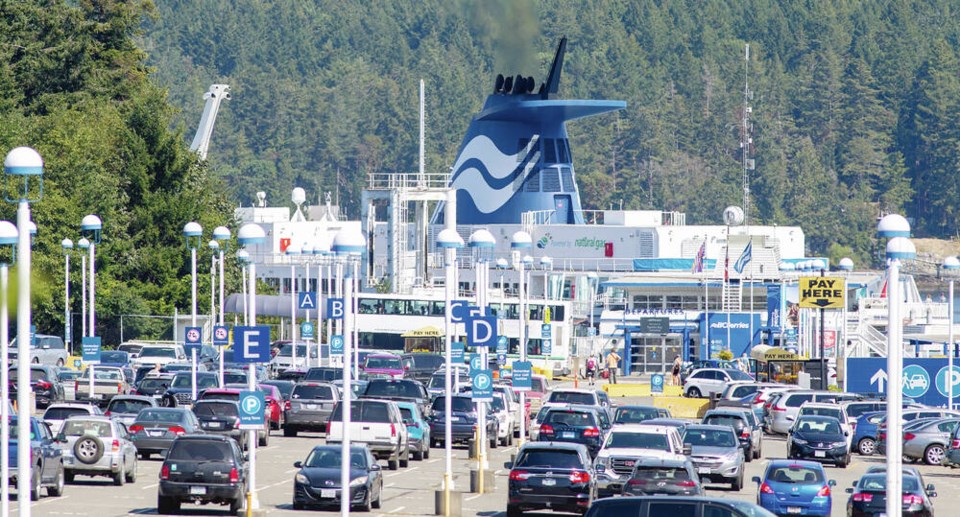sa国际传媒 Ferries carried a record 9.4 million vehicles last fiscal year even amid ongoing sailing cancellations due to crew shortages.
Demand surged when travel restrictions due to the pandemic lifted, prompting sa国际传媒 Ferries to put on 4,000 additional round trips in the past year, for a total of 86,835 round trips.
The vehicle total for the year ending March 31 was up from the previous record of 8.9 million vehicles for the year ending in spring 2019.
Passenger numbers were up by 21 per cent year-over-year, at 21.6 million people, but did not set a record. In the year ending in spring 2019, sa国际传媒 Ferries carried 22.3 million passengers, the highest level in close to two decades.
Total cancellations in the past year rose to 1.6 per cent of sailings, up from 1.2 per cent the previous year, the company said a statement.
“Like many companies facing staffing challenges, we are working hard to fill key positions to meet our commitment to our customers to deliver the service they rely on each and every day,” said sa国际传媒 Ferries chief executive Nicolas Jimenez, the former head of ICBC who took over the top job at the ferry corporation early this year after Mark Collins was fired in July 2022.
Crew shortages became an issue as the pandemic eased and travellers began riding the ferries again.
COVID, other illnesses and a staffing crunch all contributed to cancellations, which remain an issue despite company efforts to boost ranks, including cash bonuses as a hiring incentive. One challenge is competition for skilled trades workers who can make more money elsewhere.
The Brentwood Bay-Mill Bay ferry route was closed for one day last week due to a crew shortage. And on Sunday night, the 8 p.m. Swartz Bay-Tsawwassen sailing and the 10 p.m. sailing out of Tsawwassen were cancelled as well.
sa国际传媒 Ferries saw a net loss of $1.8 million in the past year, compared to net earnings of $34.1 million in the previous year, it said, although the previous year’s net earnings included $102.3 million in government safe restart funding.
Revenue for the year ending this spring was $1.04 billion, an increase of $77.4 million or eight per cent from the previous year.
The revenue boost is mainly due to an increase in vehicles and passengers due to the lifting of travel restrictions, along with retail sales proceeds.
Operating expenses climbed in the most recent fiscal year to $991.5 million, up by 14.2 per cent from $868 million the previous year. The increase was largely due to a greater number of round trips, which meant more labour and fuel costs, plus rising fuel prices, maintenance expenses and depreciation.
In the past year, the company put $131.4 million into projects such as upgrading and modifying vessels and terminals and information technology systems.
Future expenses include the rebuilding and upgrading of its shipyard, called its fleet maintenance unit, in Richmond. The cost is not being publicly revealed, but because of higher-than-anticipated bids for the job, the company had to receive permission from the sa国际传媒 Ferry Commissioner to add to its budget.
Ferry travellers are waiting until the end of September for the final word on the price cap for fares, expected to be at three per cent or lower each year for the period of April 2024 through March 2028.
The Ferry Commissioner had released a preliminary decision allowing a price cap of up to 9.2 per cent but sa国际传媒 Ferries said that level of increase was not going to be implemented. The province contributed $500 million to help sa国际传媒 Ferries keep the price cap at the lower level.
sa国际传媒 Ferries has also asked the sa国际传媒 Ferry Commissioner for permission to spend millions to modernize and streamline checking in vehicle and foot passenger arrivals at the system’s major terminals.
As for CEO compensation, Joy McPhail, sa国际传媒 Ferries board chair, said Jimenez is making the same as he did at ICBC. Jimenez’s total compensation at ICBC was $499,335, including a salary of $422,016, in the 2021-2022 year.
>>> To comment on this article, write a letter to the editor: [email protected]



